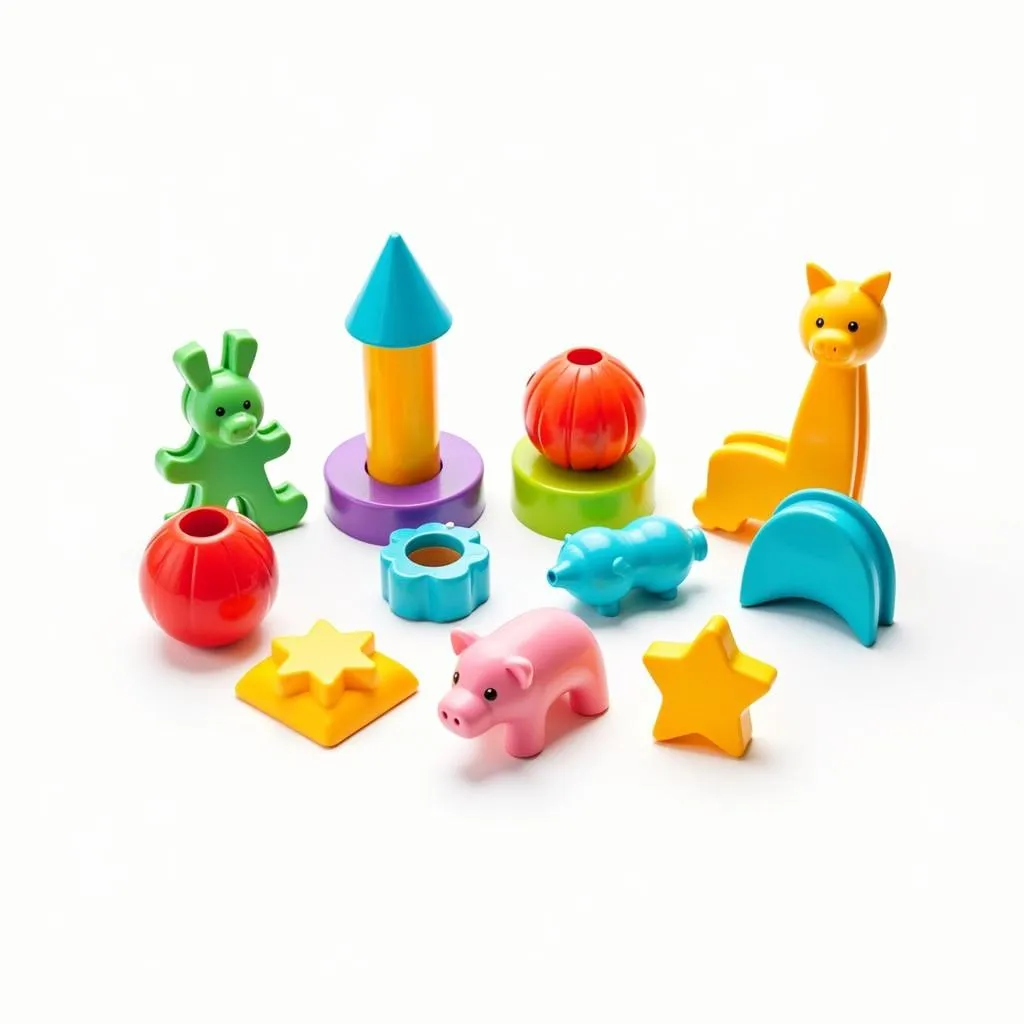“A straight tree is not afraid of standing dead, a good child is not afraid of the teacher’s anger.” This old proverb speaks to the importance of children’s education. Teachers not only impart knowledge but also guide children to develop comprehensively in physical, intellectual, and emotional aspects. Among these, preschool toys play an extremely important role, supporting teachers in teaching and creating an effective and fun learning environment for children. So, how to accurately assess the quality of preschool toys? Let’s find out in the article below!
The Role of Preschool Toys
 A diverse and plentiful set of preschool toys
A diverse and plentiful set of preschool toys
Preschool toys are not just simple entertainment items but also powerful tools to support teachers in teaching. They contribute to creating a fun learning environment, sparking curiosity, creativity, and helping children develop comprehensively in physical, intellectual, and emotional aspects.
According to preschool education expert Mr. Nguyen Van A, author of the book “Preschool Education: From Theory to Practice,” toys act as a “bridge” to help children access knowledge naturally and effectively.
Criteria for Evaluating Preschool Toys
To ensure that preschool toys meet the learning and playing needs of children, we need to rely on several specific criteria:
1. Safety
The first and most important criterion is safety. Toys must be made from safe, non-toxic materials, free of components that cause skin irritation or affect children’s health.
Priority should be given to toys made from natural wood, BPA-free plastic, or other safe materials that have been certified by functional agencies.
2. Educational Value
Besides safety, preschool toys need to have high educational value. They must be appropriate for the age group, learning ability, and development of children.
For example: Toys for 2-3 year olds can be simple stacking blocks, sensory toys such as musical toys, sand toys, or animal model toys.
For older children (4-5 years old), toys can be more complex such as motor skill games, intellectual games, role-playing games, or building block sets, science toys, etc.
3. Aesthetics
In addition to educational value, preschool toys also need to be aesthetically pleasing. The colors, shapes, and patterns of toys should attract children’s attention, creating a feeling of joy and excitement.
Note: Do not choose toys that are too colorful or have too many fussy details, which can be overwhelming or affect children’s vision.
4. Durability
Another important criterion is the durability of toys. Toys need to be made from sturdy materials, resistant to impact, and minimize the possibility of damage.
This will help toys have a long lifespan, save costs, and ensure safety for children.
5. Suitability for Children’s Needs
Finally, toys need to be suitable for the needs of children.
This includes:
- Physical needs: Motor skill toys such as slides, swings, seesaws, etc., help children develop physically and improve their health.
- Intellectual needs: Intellectual games such as puzzles, riddles, logic games, etc., help children train their brains and develop thinking and creative skills.
- Emotional needs: Model toys, role-playing games, musical toys, etc., help children develop emotions, communication skills, imagination, and artistic creativity.
Preschool Toy Evaluation Scorecard
Based on the evaluation criteria above, we can develop a preschool toy evaluation scorecard as follows:
Table 1: Preschool Toy Evaluation Scorecard
| Criteria | Weight | Score | Notes |
|---|---|---|---|
| Safety | 30% | 0-10 | |
| Educational Value | 30% | 0-10 | |
| Aesthetics | 20% | 0-10 | |
| Durability | 10% | 0-10 | |
| Suitability for Children’s Needs | 10% | 0-10 | |
| Total Score | 100% | 0-50 |
Explanation:
- Safety: The highest score is 10 points if the toy is made from safe, non-toxic materials, free of components that cause skin irritation or affect children’s health.
- Educational Value: The highest score is 10 points if the toy is appropriate for the age group, learning ability, and development of children.
- Aesthetics: The highest score is 10 points if the toy has colors, shapes, and patterns that attract children’s attention, creating a feeling of joy and excitement.
- Durability: The highest score is 10 points if the toy is made from sturdy materials, impact-resistant, and minimizes the possibility of damage.
- Suitability for Children’s Needs: The highest score is 10 points if the toy meets the physical, intellectual, and emotional needs of children.
Example:
- A set of building blocks has the following scores:
- Safety: 9 points
- Educational Value: 10 points
- Aesthetics: 8 points
- Durability: 9 points
- Suitability for Children’s Needs: 9 points
- Total Score: 45 points
Some Notes When Evaluating Preschool Toys
- Choose toys appropriate for the age group: Each age group has different needs and learning abilities. Choose toys suitable for the age of children to ensure educational effectiveness.
- Pay attention to diversity: A variety of toys should be selected to meet the diverse learning and playing needs of children.
- Observe children’s reactions: During the scoring process, it is necessary to observe children’s reactions when playing with toys. This will help you more accurately assess the attractiveness, suitability, and educational effectiveness of toys.
- Consult experts: You can consult preschool education experts for advice on choosing suitable and high-quality toys.
Conclusion
Preschool toys play an extremely important role in children’s education. Choosing and evaluating toys scientifically and appropriately will help teachers create an effective and fun learning environment, contributing to the comprehensive development of children.
Remember, “teaching letters is not as good as teaching people,” teachers need to wholeheartedly love, care for, and create the best conditions for children.
Do you have any questions about the preschool toy evaluation scorecard? Leave a comment below to get answers!